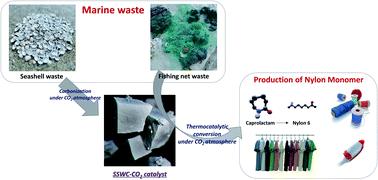当前位置:
X-MOL 学术
›
J. Mater. Chem. A
›
论文详情
Our official English website, www.x-mol.net, welcomes your
feedback! (Note: you will need to create a separate account there.)
Marine waste upcycling—recovery of nylon monomers from fishing net waste using seashell waste-derived catalysts in a CO2-mediated thermocatalytic process
Journal of Materials Chemistry A ( IF 10.7 ) Pub Date : 2022-08-02 , DOI: 10.1039/d2ta02060b Soosan Kim 1 , Yong Tae Kim 2 , Lee Seul Oh 2 , Hyung Ju Kim 2 , Jechan Lee 3
Journal of Materials Chemistry A ( IF 10.7 ) Pub Date : 2022-08-02 , DOI: 10.1039/d2ta02060b Soosan Kim 1 , Yong Tae Kim 2 , Lee Seul Oh 2 , Hyung Ju Kim 2 , Jechan Lee 3
Affiliation

|
A lot of fishing nets have been abandoned, lost, or discarded at sea. Herein, we aimed at applying seashell waste-derived catalytic materials to a thermocatalytic process to recover a valuable commodity chemical (e.g., caprolactam) from fishing net waste (FNW) made of polyamide 6. For catalyst synthesis, seashell waste was carbonized in N2 and CO2 environments (denoted as SSWC-N2 and SSWC-CO2, respectively); here, the basicity of SSWC-CO2 was two-fold more than that of SSWC-N2. The thermocatalytic conversion of FNW was also conducted under N2 and CO2 atmospheres. Using SSWC-CO2 in the thermocatalytic conversion conducted under a CO2 atmosphere maximized the caprolactam recovery (80 wt% of FNW feedstock, the highest yield reported to date) possibly because the base-catalyzed decomposition of polyamide 6 was enhanced by more reactive cleavage of the amide linkage in CO2. SSWC-CO2 was reused for at least three cycles. In conclusion, SSWC-CO2 is a promising alternative catalyst to recover caprolactam from FNW. The findings from this study offer insights into developing a new thermocatalytic upcycling process for marine waste such as FNW and seashell waste. This aids in reducing microplastic pollution and increasing economic potential for marine waste valorization.
中文翻译:

海洋废物升级循环——在二氧化碳介导的热催化过程中使用贝壳废物衍生催化剂从渔网废物中回收尼龙单体
许多渔网被遗弃、丢失或丢弃在海上。在这里,我们的目标是将贝壳废料衍生的催化材料应用于热催化过程,以从由聚酰胺 6 制成的渔网废料 (FNW)中回收有价值的商品化学品(例如己内酰胺)。对于催化剂合成,贝壳废料在 N 2中碳化和CO 2环境(分别表示为SSWC-N 2和SSWC-CO 2);在这里,SSWC-CO 2的碱度是SSWC-N 2的两倍。FNW的热催化转化也在N 2和CO 2气氛下进行。使用 SSWC-CO 2在 CO 2气氛下进行的热催化转化中,己内酰胺回收率最大化(80 wt% 的 FNW 原料,迄今为止报道的最高产率)可能是因为聚酰胺 6 的碱催化分解通过在一氧化碳2。SSWC-CO 2至少重复使用三个循环。总之,SSWC-CO 2是一种很有前途的替代催化剂,可用于从 FNW 中回收己内酰胺。这项研究的结果为开发一种新的热催化升级循环工艺用于海洋废物(如 FNW 和贝壳废物)提供了见解。这有助于减少微塑料污染并增加海洋废物增值的经济潜力。
更新日期:2022-08-02
中文翻译:

海洋废物升级循环——在二氧化碳介导的热催化过程中使用贝壳废物衍生催化剂从渔网废物中回收尼龙单体
许多渔网被遗弃、丢失或丢弃在海上。在这里,我们的目标是将贝壳废料衍生的催化材料应用于热催化过程,以从由聚酰胺 6 制成的渔网废料 (FNW)中回收有价值的商品化学品(例如己内酰胺)。对于催化剂合成,贝壳废料在 N 2中碳化和CO 2环境(分别表示为SSWC-N 2和SSWC-CO 2);在这里,SSWC-CO 2的碱度是SSWC-N 2的两倍。FNW的热催化转化也在N 2和CO 2气氛下进行。使用 SSWC-CO 2在 CO 2气氛下进行的热催化转化中,己内酰胺回收率最大化(80 wt% 的 FNW 原料,迄今为止报道的最高产率)可能是因为聚酰胺 6 的碱催化分解通过在一氧化碳2。SSWC-CO 2至少重复使用三个循环。总之,SSWC-CO 2是一种很有前途的替代催化剂,可用于从 FNW 中回收己内酰胺。这项研究的结果为开发一种新的热催化升级循环工艺用于海洋废物(如 FNW 和贝壳废物)提供了见解。这有助于减少微塑料污染并增加海洋废物增值的经济潜力。











































 京公网安备 11010802027423号
京公网安备 11010802027423号